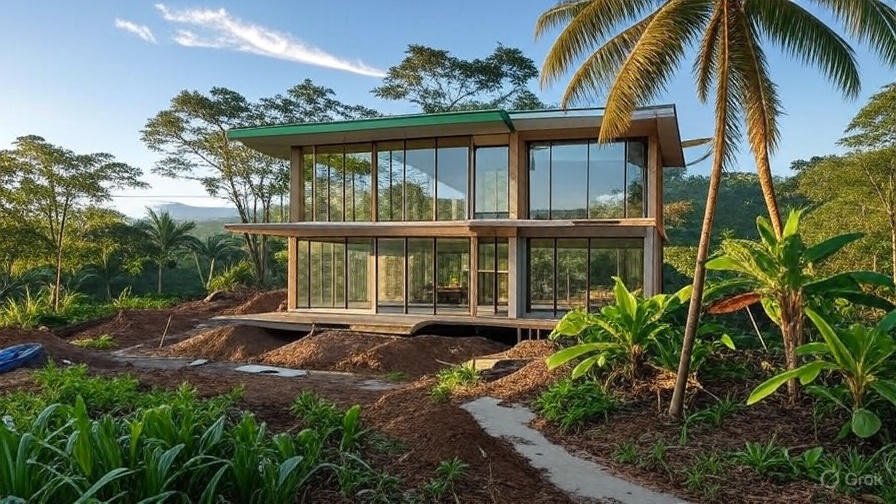Costa Rica continues to captivate the imaginations of expats, retirees, and digital nomads alike, drawn by its stunning landscapes, stable political climate, and welcoming environment for foreign investment. With its lush rainforests, pristine beaches, and vibrant communities, the country has become a hotspot for those looking to build their dream homes. Whether you’re envisioning a modern beachfront villa in Tamarindo or a sustainable jungle retreat in Uvita, building a house in Costa Rica is an exciting yet complex process that requires careful planning and local expertise. This comprehensive guide, updated for 2025, outlines the essential steps, costs, and considerations to help you navigate the journey with confidence.
Why Choose Costa Rica for Your Home-Building Project?
Costa Rica’s appeal as a destination for home construction lies in its unique blend of natural beauty, affordability, and accessibility. The country boasts low property taxes, a stable democracy, and a legal system that grants foreigners the same property ownership rights as citizens. This makes it one of the most foreigner-friendly countries in Latin America for real estate investment. According to a recent report by the Costa Rican Chamber of Construction, residential construction projects have surged by 15% in 2024, driven by demand in areas like Nosara, Santa Teresa, and the Central Valley.
From coastal towns to mountain highlands, Costa Rica offers diverse climates and lifestyles to suit every preference. Whether you’re seeking a serene off-grid home or a luxurious estate with ocean views, the country’s growing infrastructure and expat communities make it an ideal place to build. However, success hinges on understanding the local regulations, climate considerations, and construction processes.
Step 1: Finding and Securing the Right Land
The first step in building a house in Costa Rica is selecting a suitable plot of land. Not all properties are zoned for residential construction, so due diligence is critical. Each municipality enforces specific zoning regulations, known as Uso de Suelo, which dictate what can be built on a given parcel. For instance, some coastal areas may have restrictions due to environmental protections or maritime zone laws.
Before purchasing, engage a reputable architectural or engineering firm to conduct a feasibility study. This includes topographic surveys, soil analysis, and verification of utility access (water, electricity, and internet). Firms like Brunka Architects & Engineers specialize in these assessments, ensuring your land is buildable and aligns with your vision. A thorough land evaluation can prevent costly surprises, such as discovering your plot is in a protected ecological zone.
Step 2: Budgeting for Your Dream Home
Costs for building a house in Costa Rica vary depending on location, materials, and design complexity. As of 2025, industry estimates suggest:
- Standard homes: $1,000–$1,300 per square meter
- High-end custom homes: $1,400–$1,800 per square meter
- Sustainable or off-grid homes: Costs vary based on technologies like solar panels or rainwater systems
Beyond construction, factor in additional expenses such as architectural and engineering fees (typically 8–12% of the project cost), permits, and contingencies for unexpected delays. For example, rainy season weather (May to November) can slow progress, so budgeting for a 10–15% contingency is wise. Transparent project management, including regular financial updates, can help keep costs in check.
Step 3: Designing for Costa Rica’s Unique Climate
Costa Rica’s tropical climate demands thoughtful architectural design. Unlike temperate regions, homes here must prioritize passive cooling, effective drainage, and seismic resilience. Key design considerations include:
- Passive cooling: Incorporate cross-ventilation, large windows, and overhangs to reduce reliance on air conditioning.
- Rain management: Sloped roofs and robust drainage systems are essential to handle heavy rainfall.
- Seismic safety: Costa Rica is seismically active, so reinforced foundations and structural bracing are mandatory.
Working with a CFIA-certified architect ensures your design meets both aesthetic and functional needs. Many firms now offer 3D renderings, allowing you to visualize your home before construction begins. For inspiration, explore modern home design trends for 2025 that blend sustainability with style.
Before construction can start, your plans must be approved by the Colegio Federado de Ingenieros y de Arquitectos (CFIA) and the local municipality. This process ensures compliance with national building codes and local regulations. Required approvals include:
- Municipal construction permits
- CFIA project registration
- Utility connections (water via AYA, electricity via ICE)
- Environmental clearance from SETENA for certain projects
Permit processing times vary by region, typically taking 2–6 weeks. Experienced firms can streamline this process by preparing all necessary documentation, including structural, electrical, and plumbing plans.
Step 5: The Construction Process
Once permits are secured, construction can begin. The timeline for building a house in Costa Rica ranges from 6 to 12 months, depending on the project’s scale and weather conditions. Key phases include:
- Site preparation: Clearing land, laying foundations, and setting up utilities.
- Structural work: Building the frame, walls, and roof.
- Finishing: Installing plumbing, electrical systems, and interior finishes.
Effective project management is crucial to avoid delays or cost overruns. Many firms offer digital dashboards for real-time updates, including photos, videos, and budget tracking. For expats building remotely, bilingual contracts and regular communication ensure transparency.
Special Considerations for Foreign Buyers
Foreigners face no legal barriers to owning property or building a house in Costa Rica, but navigating the process requires local expertise. Setting up a Costa Rican corporation (S.A.) is a common way to hold property, offering tax benefits and legal clarity. A trusted attorney can guide you through this process, while architects and engineers can manage construction remotely, providing updates via video or email.
For off-grid enthusiasts, Costa Rica is a leader in sustainable building. Solar power, rainwater harvesting, and composting systems are increasingly popular, particularly in remote areas like the Osa Peninsula. Discuss your goals with your design team to integrate these features seamlessly.
Challenges and How to Overcome Them
While building in Costa Rica is rewarding, challenges can arise. The rainy season can delay construction, so scheduling work during the dry season (December to April) is ideal. Supply chain issues, particularly for imported materials, can also increase costs. Local sourcing, when possible, mitigates this risk. Finally, cultural differences in business practices may require patience—working with bilingual professionals can bridge this gap.
Final Steps: From Construction to Move-In
Once construction is complete, your home will need a Habite certificate, confirming it meets all building codes and is ready for occupancy. This final inspection is conducted by the municipality and CFIA. After approval, you can connect utilities and prepare to move in.
Building a house in Costa Rica is a journey that blends vision, planning, and local expertise. By partnering with experienced professionals, you can turn your dream home into reality while navigating the complexities of permits, construction, and cultural nuances.
Ready to Start?
With its unparalleled natural beauty and welcoming environment, Costa Rica is the perfect place to build your dream home. Whether you’re a local or an expat, the key to success lies in thorough planning and working with trusted professionals. Firms like Brunka Architects & Engineers offer end-to-end services, from land selection to move-in, ensuring a seamless experience. Start your journey today and make your Costa Rican home a reality in 2025.
Contents
- 1 Why Choose Costa Rica for Your Home-Building Project?
- 2 Step 1: Finding and Securing the Right Land
- 3 Step 2: Budgeting for Your Dream Home
- 4 Step 3: Designing for Costa Rica’s Unique Climate
- 5 Step 4: Navigating Permits and Approvals
- 6 Step 5: The Construction Process
- 7 Special Considerations for Foreign Buyers
- 8 Challenges and How to Overcome Them
- 9 Final Steps: From Construction to Move-In
- 10 Ready to Start?




